Project Quality Management Plan and Global Team Challenges Report
VerifiedAdded on 2019/10/31
|13
|3058
|214
Report
AI Summary
This report delves into the critical aspects of project quality management, particularly within the context of global teams. It begins by outlining the fundamental phases of project management, including conception and initiation, planning, execution, monitoring and controlling, and closing. The core of the report focuses on the development and implementation of a project quality management plan, emphasizing the importance of quality assurance, quality control, and establishing clear quality standards. It then addresses the unique challenges that global teams face, such as cultural differences, varying management structures, and technological disparities. The report proposes practical solutions to these challenges, including fostering cultural awareness, establishing team rules and regulations, deriving a common management structure, and providing comprehensive training to team members. By addressing these issues, the report aims to provide a framework for successful project outcomes in global collaborative environments.
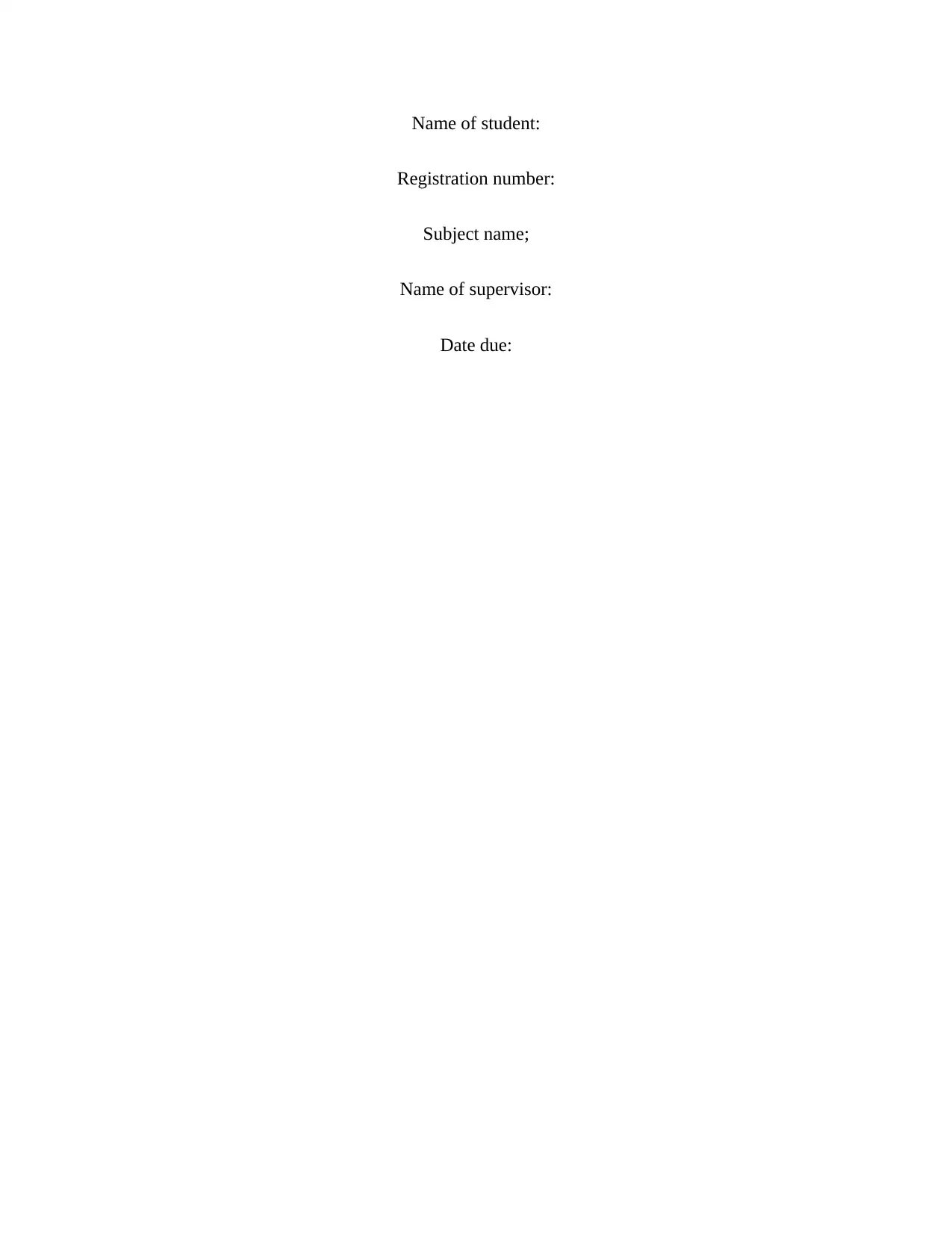
Name of student:
Registration number:
Subject name;
Name of supervisor:
Date due:
Registration number:
Subject name;
Name of supervisor:
Date due:
Paraphrase This Document
Need a fresh take? Get an instant paraphrase of this document with our AI Paraphraser
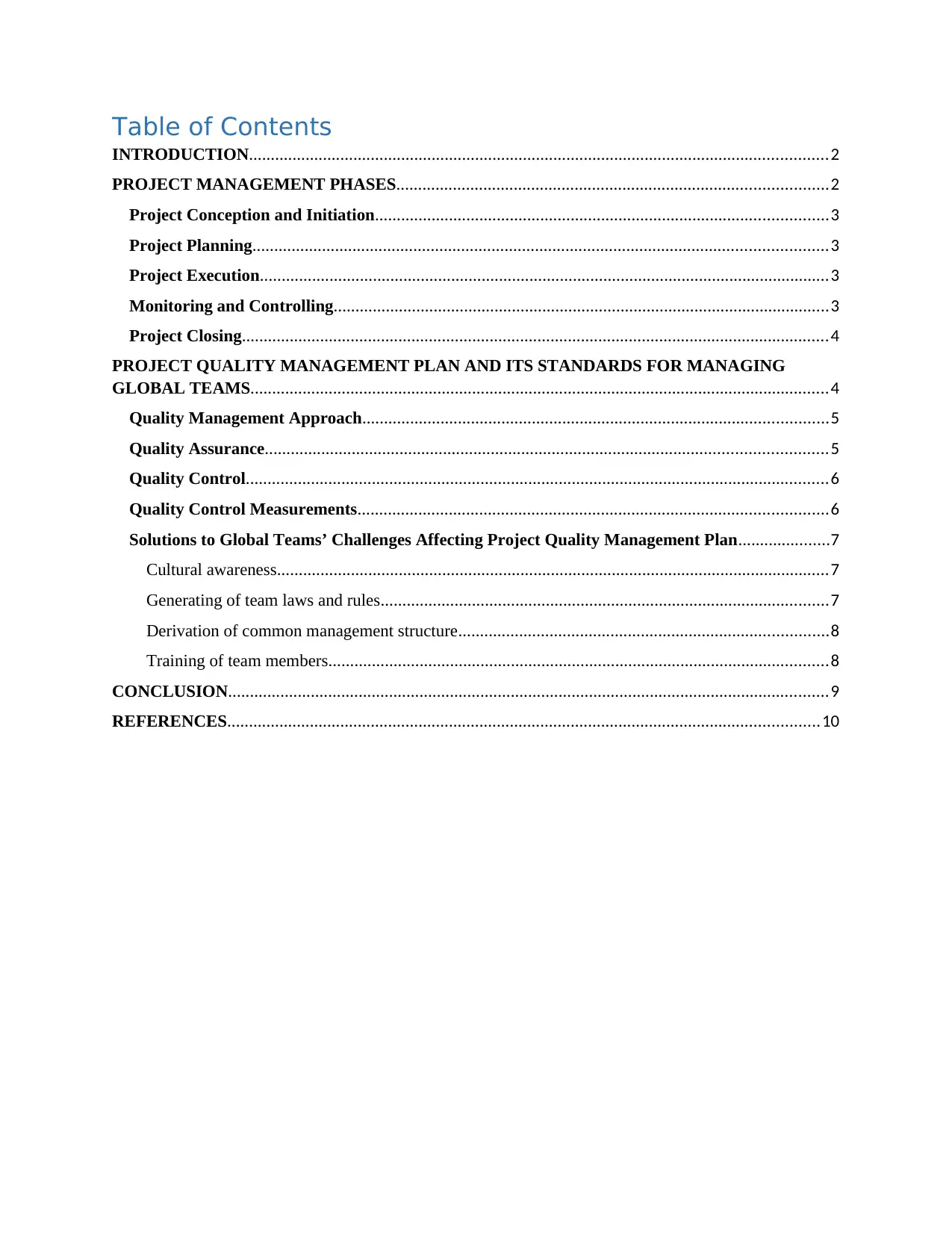
Table of Contents
INTRODUCTION.....................................................................................................................................2
PROJECT MANAGEMENT PHASES...................................................................................................2
Project Conception and Initiation........................................................................................................3
Project Planning....................................................................................................................................3
Project Execution...................................................................................................................................3
Monitoring and Controlling..................................................................................................................3
Project Closing.......................................................................................................................................4
PROJECT QUALITY MANAGEMENT PLAN AND ITS STANDARDS FOR MANAGING
GLOBAL TEAMS.....................................................................................................................................4
Quality Management Approach...........................................................................................................5
Quality Assurance.................................................................................................................................5
Quality Control......................................................................................................................................6
Quality Control Measurements............................................................................................................6
Solutions to Global Teams’ Challenges Affecting Project Quality Management Plan.....................7
Cultural awareness...............................................................................................................................7
Generating of team laws and rules.......................................................................................................7
Derivation of common management structure.....................................................................................8
Training of team members...................................................................................................................8
CONCLUSION..........................................................................................................................................9
REFERENCES........................................................................................................................................10
INTRODUCTION.....................................................................................................................................2
PROJECT MANAGEMENT PHASES...................................................................................................2
Project Conception and Initiation........................................................................................................3
Project Planning....................................................................................................................................3
Project Execution...................................................................................................................................3
Monitoring and Controlling..................................................................................................................3
Project Closing.......................................................................................................................................4
PROJECT QUALITY MANAGEMENT PLAN AND ITS STANDARDS FOR MANAGING
GLOBAL TEAMS.....................................................................................................................................4
Quality Management Approach...........................................................................................................5
Quality Assurance.................................................................................................................................5
Quality Control......................................................................................................................................6
Quality Control Measurements............................................................................................................6
Solutions to Global Teams’ Challenges Affecting Project Quality Management Plan.....................7
Cultural awareness...............................................................................................................................7
Generating of team laws and rules.......................................................................................................7
Derivation of common management structure.....................................................................................8
Training of team members...................................................................................................................8
CONCLUSION..........................................................................................................................................9
REFERENCES........................................................................................................................................10
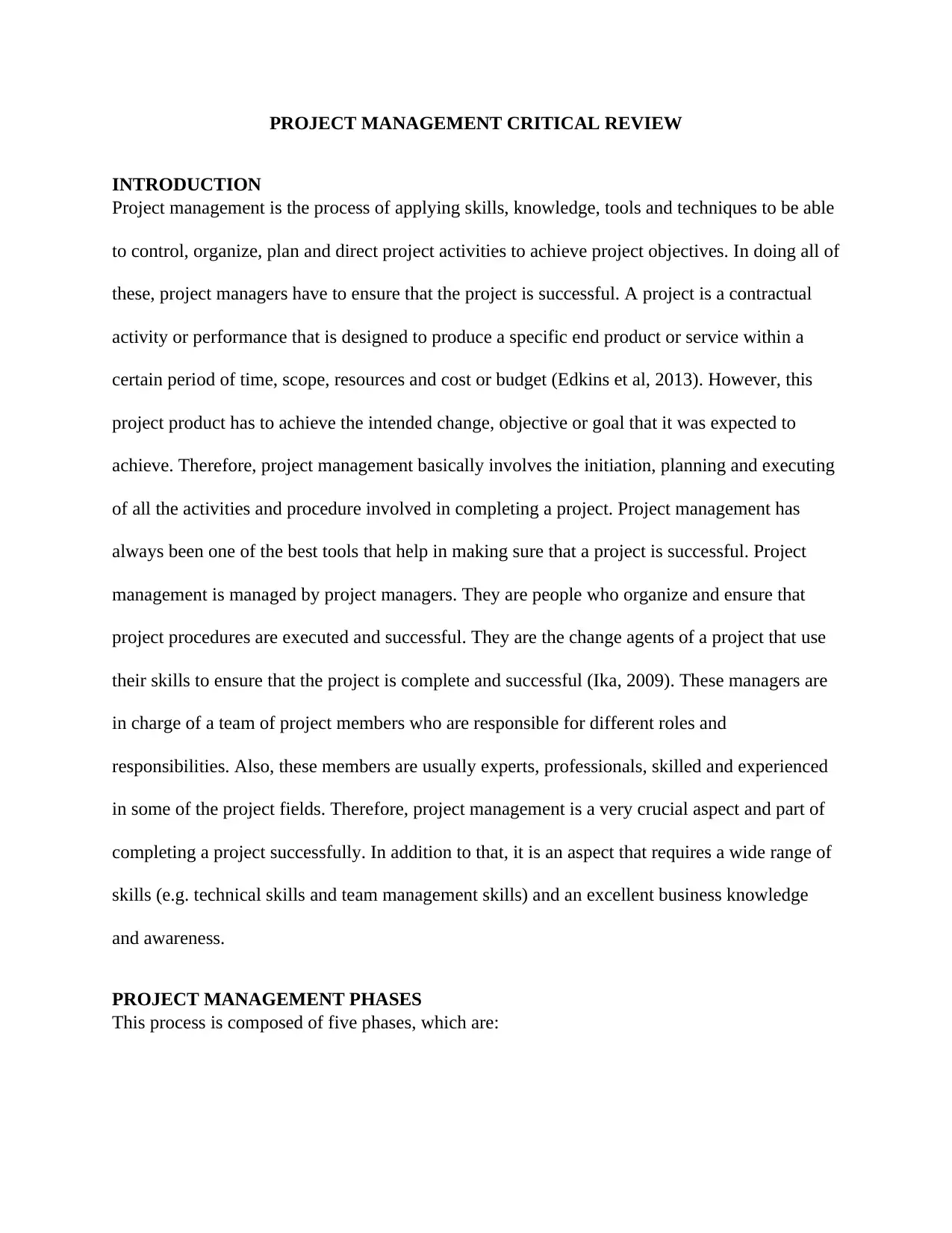
PROJECT MANAGEMENT CRITICAL REVIEW
INTRODUCTION
Project management is the process of applying skills, knowledge, tools and techniques to be able
to control, organize, plan and direct project activities to achieve project objectives. In doing all of
these, project managers have to ensure that the project is successful. A project is a contractual
activity or performance that is designed to produce a specific end product or service within a
certain period of time, scope, resources and cost or budget (Edkins et al, 2013). However, this
project product has to achieve the intended change, objective or goal that it was expected to
achieve. Therefore, project management basically involves the initiation, planning and executing
of all the activities and procedure involved in completing a project. Project management has
always been one of the best tools that help in making sure that a project is successful. Project
management is managed by project managers. They are people who organize and ensure that
project procedures are executed and successful. They are the change agents of a project that use
their skills to ensure that the project is complete and successful (Ika, 2009). These managers are
in charge of a team of project members who are responsible for different roles and
responsibilities. Also, these members are usually experts, professionals, skilled and experienced
in some of the project fields. Therefore, project management is a very crucial aspect and part of
completing a project successfully. In addition to that, it is an aspect that requires a wide range of
skills (e.g. technical skills and team management skills) and an excellent business knowledge
and awareness.
PROJECT MANAGEMENT PHASES
This process is composed of five phases, which are:
INTRODUCTION
Project management is the process of applying skills, knowledge, tools and techniques to be able
to control, organize, plan and direct project activities to achieve project objectives. In doing all of
these, project managers have to ensure that the project is successful. A project is a contractual
activity or performance that is designed to produce a specific end product or service within a
certain period of time, scope, resources and cost or budget (Edkins et al, 2013). However, this
project product has to achieve the intended change, objective or goal that it was expected to
achieve. Therefore, project management basically involves the initiation, planning and executing
of all the activities and procedure involved in completing a project. Project management has
always been one of the best tools that help in making sure that a project is successful. Project
management is managed by project managers. They are people who organize and ensure that
project procedures are executed and successful. They are the change agents of a project that use
their skills to ensure that the project is complete and successful (Ika, 2009). These managers are
in charge of a team of project members who are responsible for different roles and
responsibilities. Also, these members are usually experts, professionals, skilled and experienced
in some of the project fields. Therefore, project management is a very crucial aspect and part of
completing a project successfully. In addition to that, it is an aspect that requires a wide range of
skills (e.g. technical skills and team management skills) and an excellent business knowledge
and awareness.
PROJECT MANAGEMENT PHASES
This process is composed of five phases, which are:
⊘ This is a preview!⊘
Do you want full access?
Subscribe today to unlock all pages.

Trusted by 1+ million students worldwide

Project Conception and Initiation
In this phase, the business owners and stakeholders come up with a project idea and it is
analyzed in details. They later get permission from the required authorities to officially start the
project. To add to that, the business needs/requirements are analyzed, project needs and
requirements, business’s financial status among other things. After analyzing the business and
project’s needs, the decision-making team has to prove whether the project will be beneficial to
the business or not (Howsawi et al, 2011). This means that the project objectives, aims, project
manager identification and change expectations have to be set.
Project Planning
This includes the writing down of the project scope and all activities that are to be performed for
the completion of the project. These activities include the actual project schedule, resource list,
team members and their roles and responsibilities, project budget estimation, project’s time
period among other things.
Project Execution
This phase involves the carrying out of the project’s plan or rather implementation of the project
plan, i.e. performing the activities that have been listed in the project plan. This means that every
person/team member has to have all the details of their role and responsibility for them to carry
out a certain duty.
Monitoring and Controlling
In this phase, the project performance is compared with the actual project plan to ensure that
everything is carried out and complete. In that case, the team members have to ensure that they
maintain their schedules. The project managers must ensure that the project is still adhered to,
reports presented to the people responsible, project scope is achieved, project quality is
In this phase, the business owners and stakeholders come up with a project idea and it is
analyzed in details. They later get permission from the required authorities to officially start the
project. To add to that, the business needs/requirements are analyzed, project needs and
requirements, business’s financial status among other things. After analyzing the business and
project’s needs, the decision-making team has to prove whether the project will be beneficial to
the business or not (Howsawi et al, 2011). This means that the project objectives, aims, project
manager identification and change expectations have to be set.
Project Planning
This includes the writing down of the project scope and all activities that are to be performed for
the completion of the project. These activities include the actual project schedule, resource list,
team members and their roles and responsibilities, project budget estimation, project’s time
period among other things.
Project Execution
This phase involves the carrying out of the project’s plan or rather implementation of the project
plan, i.e. performing the activities that have been listed in the project plan. This means that every
person/team member has to have all the details of their role and responsibility for them to carry
out a certain duty.
Monitoring and Controlling
In this phase, the project performance is compared with the actual project plan to ensure that
everything is carried out and complete. In that case, the team members have to ensure that they
maintain their schedules. The project managers must ensure that the project is still adhered to,
reports presented to the people responsible, project scope is achieved, project quality is
Paraphrase This Document
Need a fresh take? Get an instant paraphrase of this document with our AI Paraphraser

maintained and risks are controlled (Howsawi et al, 2011). In other words, the project managers
must ensure that the project is adhering to the actual project plan and maintains the right track.
Project Closing
Involves the project result/outcome evaluation after all the project tasks are complete and done
with and the project end product is officially approved. This phase includes project team
member’s evaluation as well. The project scope is verified to ensure that all the project
deliverables and expectations are met and according to satisfactory standards.
PROJECT QUALITY MANAGEMENT PLAN AND ITS STANDARDS FOR
MANAGING GLOBAL TEAMS
Project quality management plan involves ensuring that project management is up to and beyond
the client’s expectations. This means that, for the managers to provide quality project
management, they have to have a very good, effective and efficient plan on how to carry out a
certain specific project. This includes providing more specific details for every project
management phase and any activity to the team members as well as to the project decision
makers (Zafarani, 2011). Therefore, this makes the implementation of a project quality
management plan the first step for project managers in achieving project objectives and success.
In that case, the following need to be addressed in a project quality management plan, for every
project:
Ensure that project quality is planned
Definition of how the project quality will be managed
Definition of all the quality assurance activities
Listing and defining any quality control activities
Listing and defining the acceptable quality standards
must ensure that the project is adhering to the actual project plan and maintains the right track.
Project Closing
Involves the project result/outcome evaluation after all the project tasks are complete and done
with and the project end product is officially approved. This phase includes project team
member’s evaluation as well. The project scope is verified to ensure that all the project
deliverables and expectations are met and according to satisfactory standards.
PROJECT QUALITY MANAGEMENT PLAN AND ITS STANDARDS FOR
MANAGING GLOBAL TEAMS
Project quality management plan involves ensuring that project management is up to and beyond
the client’s expectations. This means that, for the managers to provide quality project
management, they have to have a very good, effective and efficient plan on how to carry out a
certain specific project. This includes providing more specific details for every project
management phase and any activity to the team members as well as to the project decision
makers (Zafarani, 2011). Therefore, this makes the implementation of a project quality
management plan the first step for project managers in achieving project objectives and success.
In that case, the following need to be addressed in a project quality management plan, for every
project:
Ensure that project quality is planned
Definition of how the project quality will be managed
Definition of all the quality assurance activities
Listing and defining any quality control activities
Listing and defining the acceptable quality standards
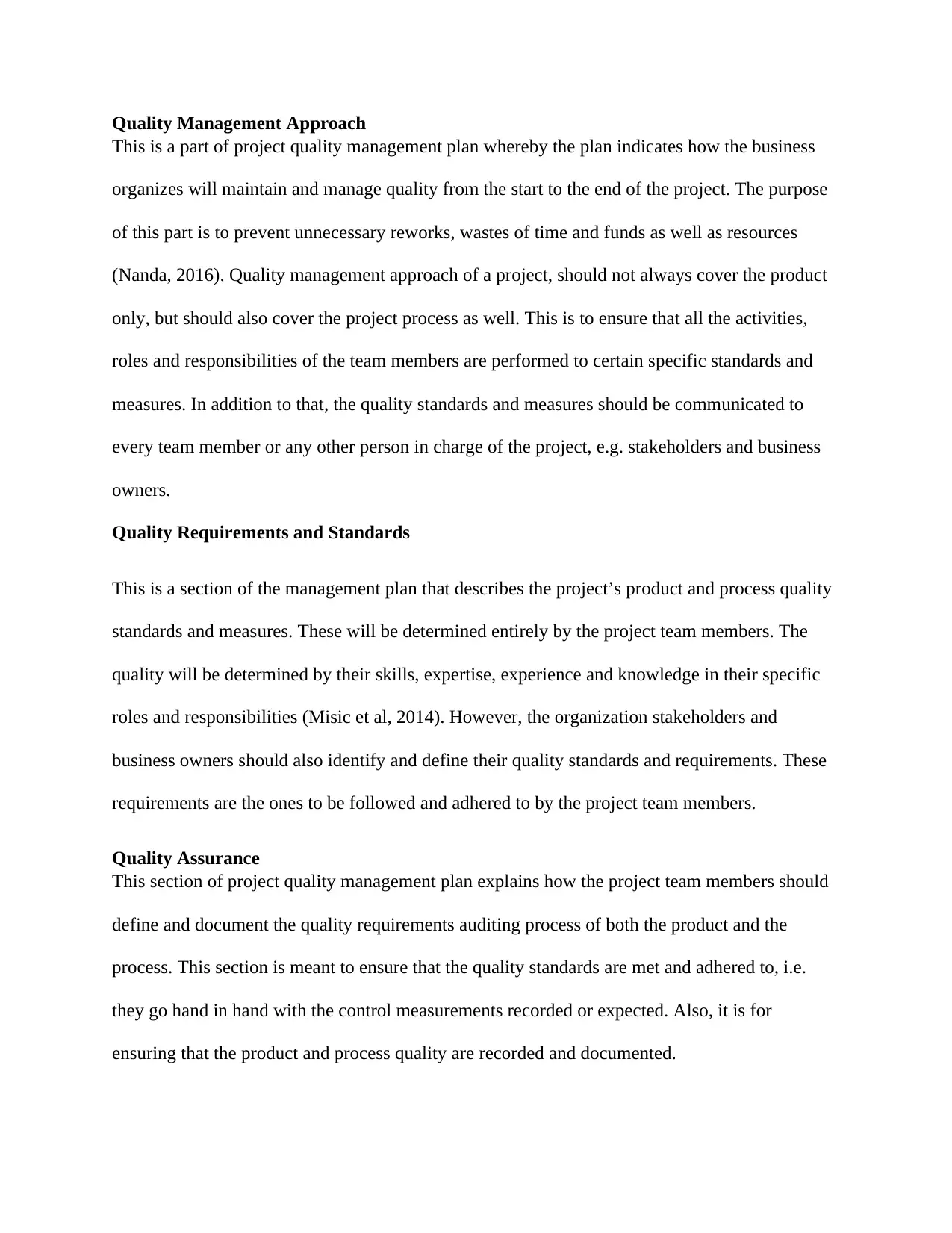
Quality Management Approach
This is a part of project quality management plan whereby the plan indicates how the business
organizes will maintain and manage quality from the start to the end of the project. The purpose
of this part is to prevent unnecessary reworks, wastes of time and funds as well as resources
(Nanda, 2016). Quality management approach of a project, should not always cover the product
only, but should also cover the project process as well. This is to ensure that all the activities,
roles and responsibilities of the team members are performed to certain specific standards and
measures. In addition to that, the quality standards and measures should be communicated to
every team member or any other person in charge of the project, e.g. stakeholders and business
owners.
Quality Requirements and Standards
This is a section of the management plan that describes the project’s product and process quality
standards and measures. These will be determined entirely by the project team members. The
quality will be determined by their skills, expertise, experience and knowledge in their specific
roles and responsibilities (Misic et al, 2014). However, the organization stakeholders and
business owners should also identify and define their quality standards and requirements. These
requirements are the ones to be followed and adhered to by the project team members.
Quality Assurance
This section of project quality management plan explains how the project team members should
define and document the quality requirements auditing process of both the product and the
process. This section is meant to ensure that the quality standards are met and adhered to, i.e.
they go hand in hand with the control measurements recorded or expected. Also, it is for
ensuring that the product and process quality are recorded and documented.
This is a part of project quality management plan whereby the plan indicates how the business
organizes will maintain and manage quality from the start to the end of the project. The purpose
of this part is to prevent unnecessary reworks, wastes of time and funds as well as resources
(Nanda, 2016). Quality management approach of a project, should not always cover the product
only, but should also cover the project process as well. This is to ensure that all the activities,
roles and responsibilities of the team members are performed to certain specific standards and
measures. In addition to that, the quality standards and measures should be communicated to
every team member or any other person in charge of the project, e.g. stakeholders and business
owners.
Quality Requirements and Standards
This is a section of the management plan that describes the project’s product and process quality
standards and measures. These will be determined entirely by the project team members. The
quality will be determined by their skills, expertise, experience and knowledge in their specific
roles and responsibilities (Misic et al, 2014). However, the organization stakeholders and
business owners should also identify and define their quality standards and requirements. These
requirements are the ones to be followed and adhered to by the project team members.
Quality Assurance
This section of project quality management plan explains how the project team members should
define and document the quality requirements auditing process of both the product and the
process. This section is meant to ensure that the quality standards are met and adhered to, i.e.
they go hand in hand with the control measurements recorded or expected. Also, it is for
ensuring that the product and process quality are recorded and documented.
⊘ This is a preview!⊘
Do you want full access?
Subscribe today to unlock all pages.

Trusted by 1+ million students worldwide
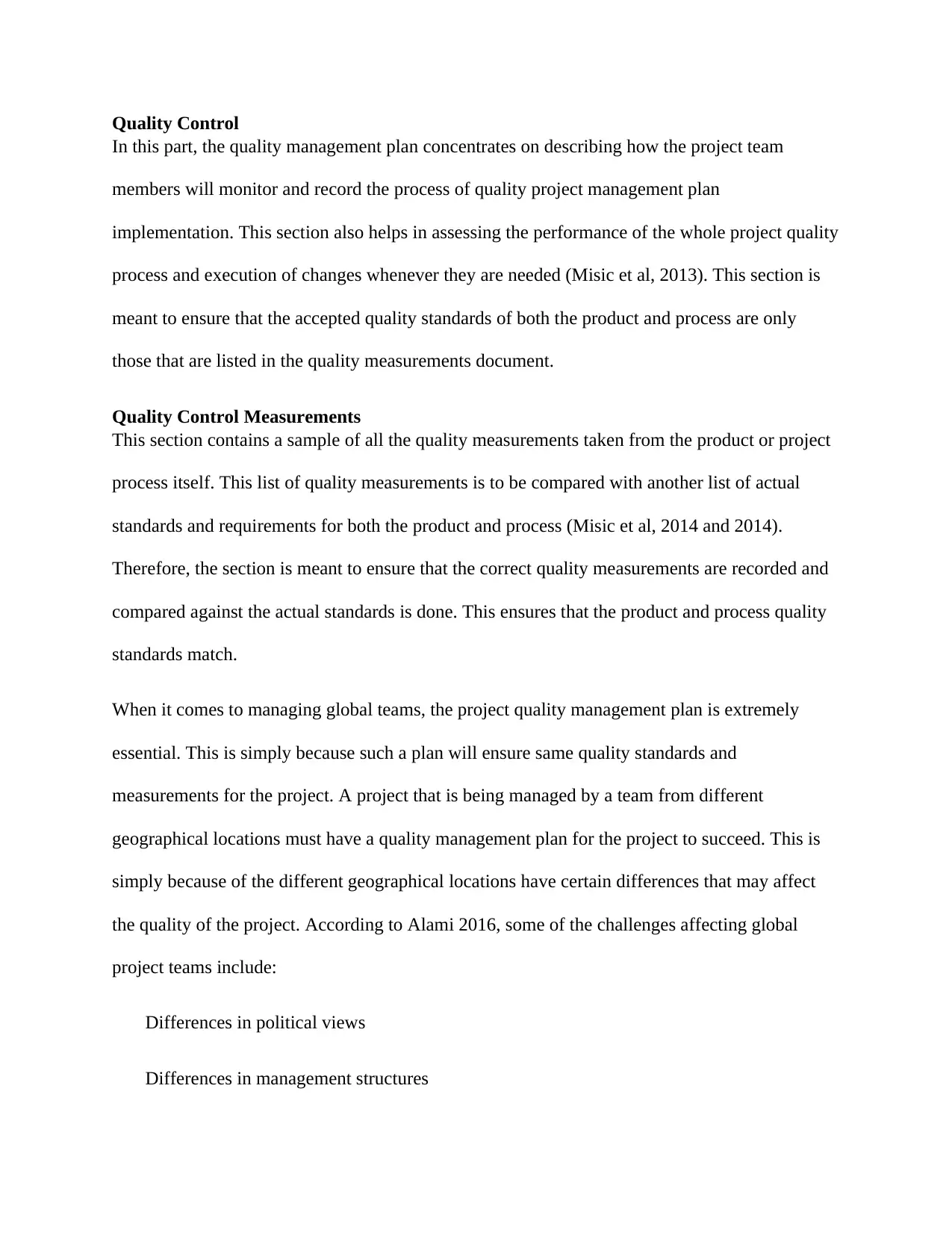
Quality Control
In this part, the quality management plan concentrates on describing how the project team
members will monitor and record the process of quality project management plan
implementation. This section also helps in assessing the performance of the whole project quality
process and execution of changes whenever they are needed (Misic et al, 2013). This section is
meant to ensure that the accepted quality standards of both the product and process are only
those that are listed in the quality measurements document.
Quality Control Measurements
This section contains a sample of all the quality measurements taken from the product or project
process itself. This list of quality measurements is to be compared with another list of actual
standards and requirements for both the product and process (Misic et al, 2014 and 2014).
Therefore, the section is meant to ensure that the correct quality measurements are recorded and
compared against the actual standards is done. This ensures that the product and process quality
standards match.
When it comes to managing global teams, the project quality management plan is extremely
essential. This is simply because such a plan will ensure same quality standards and
measurements for the project. A project that is being managed by a team from different
geographical locations must have a quality management plan for the project to succeed. This is
simply because of the different geographical locations have certain differences that may affect
the quality of the project. According to Alami 2016, some of the challenges affecting global
project teams include:
Differences in political views
Differences in management structures
In this part, the quality management plan concentrates on describing how the project team
members will monitor and record the process of quality project management plan
implementation. This section also helps in assessing the performance of the whole project quality
process and execution of changes whenever they are needed (Misic et al, 2013). This section is
meant to ensure that the accepted quality standards of both the product and process are only
those that are listed in the quality measurements document.
Quality Control Measurements
This section contains a sample of all the quality measurements taken from the product or project
process itself. This list of quality measurements is to be compared with another list of actual
standards and requirements for both the product and process (Misic et al, 2014 and 2014).
Therefore, the section is meant to ensure that the correct quality measurements are recorded and
compared against the actual standards is done. This ensures that the product and process quality
standards match.
When it comes to managing global teams, the project quality management plan is extremely
essential. This is simply because such a plan will ensure same quality standards and
measurements for the project. A project that is being managed by a team from different
geographical locations must have a quality management plan for the project to succeed. This is
simply because of the different geographical locations have certain differences that may affect
the quality of the project. According to Alami 2016, some of the challenges affecting global
project teams include:
Differences in political views
Differences in management structures
Paraphrase This Document
Need a fresh take? Get an instant paraphrase of this document with our AI Paraphraser
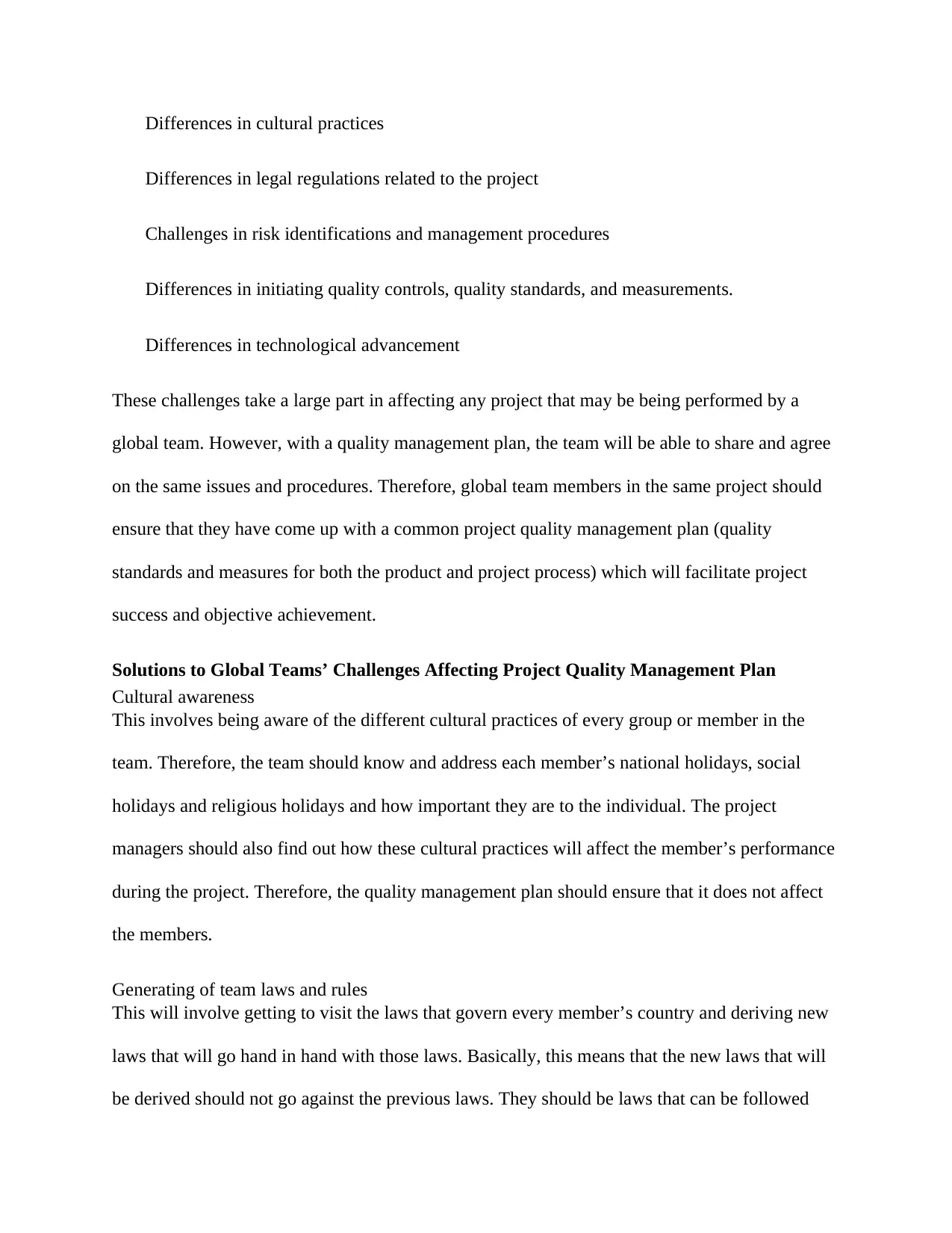
Differences in cultural practices
Differences in legal regulations related to the project
Challenges in risk identifications and management procedures
Differences in initiating quality controls, quality standards, and measurements.
Differences in technological advancement
These challenges take a large part in affecting any project that may be being performed by a
global team. However, with a quality management plan, the team will be able to share and agree
on the same issues and procedures. Therefore, global team members in the same project should
ensure that they have come up with a common project quality management plan (quality
standards and measures for both the product and project process) which will facilitate project
success and objective achievement.
Solutions to Global Teams’ Challenges Affecting Project Quality Management Plan
Cultural awareness
This involves being aware of the different cultural practices of every group or member in the
team. Therefore, the team should know and address each member’s national holidays, social
holidays and religious holidays and how important they are to the individual. The project
managers should also find out how these cultural practices will affect the member’s performance
during the project. Therefore, the quality management plan should ensure that it does not affect
the members.
Generating of team laws and rules
This will involve getting to visit the laws that govern every member’s country and deriving new
laws that will go hand in hand with those laws. Basically, this means that the new laws that will
be derived should not go against the previous laws. They should be laws that can be followed
Differences in legal regulations related to the project
Challenges in risk identifications and management procedures
Differences in initiating quality controls, quality standards, and measurements.
Differences in technological advancement
These challenges take a large part in affecting any project that may be being performed by a
global team. However, with a quality management plan, the team will be able to share and agree
on the same issues and procedures. Therefore, global team members in the same project should
ensure that they have come up with a common project quality management plan (quality
standards and measures for both the product and project process) which will facilitate project
success and objective achievement.
Solutions to Global Teams’ Challenges Affecting Project Quality Management Plan
Cultural awareness
This involves being aware of the different cultural practices of every group or member in the
team. Therefore, the team should know and address each member’s national holidays, social
holidays and religious holidays and how important they are to the individual. The project
managers should also find out how these cultural practices will affect the member’s performance
during the project. Therefore, the quality management plan should ensure that it does not affect
the members.
Generating of team laws and rules
This will involve getting to visit the laws that govern every member’s country and deriving new
laws that will go hand in hand with those laws. Basically, this means that the new laws that will
be derived should not go against the previous laws. They should be laws that can be followed
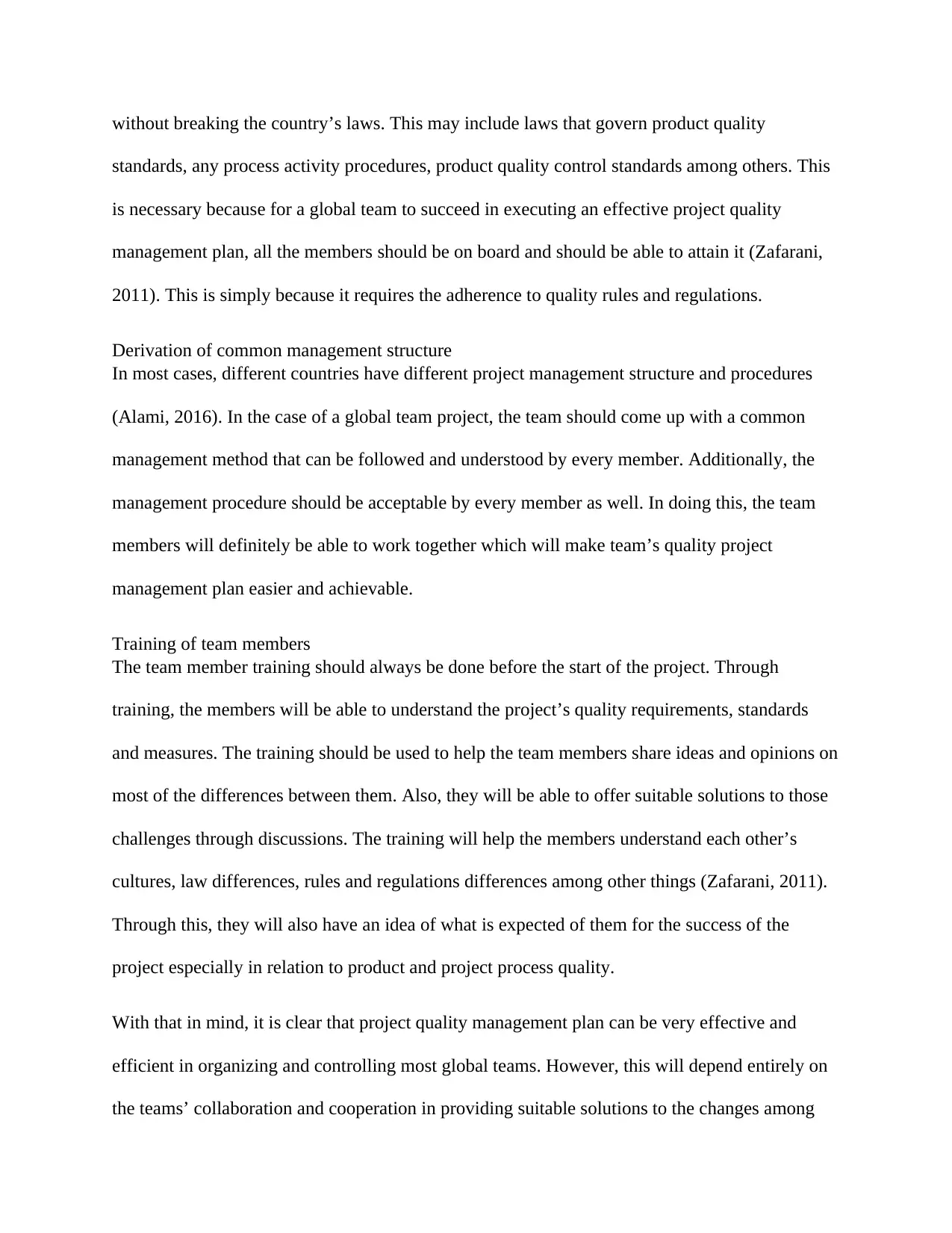
without breaking the country’s laws. This may include laws that govern product quality
standards, any process activity procedures, product quality control standards among others. This
is necessary because for a global team to succeed in executing an effective project quality
management plan, all the members should be on board and should be able to attain it (Zafarani,
2011). This is simply because it requires the adherence to quality rules and regulations.
Derivation of common management structure
In most cases, different countries have different project management structure and procedures
(Alami, 2016). In the case of a global team project, the team should come up with a common
management method that can be followed and understood by every member. Additionally, the
management procedure should be acceptable by every member as well. In doing this, the team
members will definitely be able to work together which will make team’s quality project
management plan easier and achievable.
Training of team members
The team member training should always be done before the start of the project. Through
training, the members will be able to understand the project’s quality requirements, standards
and measures. The training should be used to help the team members share ideas and opinions on
most of the differences between them. Also, they will be able to offer suitable solutions to those
challenges through discussions. The training will help the members understand each other’s
cultures, law differences, rules and regulations differences among other things (Zafarani, 2011).
Through this, they will also have an idea of what is expected of them for the success of the
project especially in relation to product and project process quality.
With that in mind, it is clear that project quality management plan can be very effective and
efficient in organizing and controlling most global teams. However, this will depend entirely on
the teams’ collaboration and cooperation in providing suitable solutions to the changes among
standards, any process activity procedures, product quality control standards among others. This
is necessary because for a global team to succeed in executing an effective project quality
management plan, all the members should be on board and should be able to attain it (Zafarani,
2011). This is simply because it requires the adherence to quality rules and regulations.
Derivation of common management structure
In most cases, different countries have different project management structure and procedures
(Alami, 2016). In the case of a global team project, the team should come up with a common
management method that can be followed and understood by every member. Additionally, the
management procedure should be acceptable by every member as well. In doing this, the team
members will definitely be able to work together which will make team’s quality project
management plan easier and achievable.
Training of team members
The team member training should always be done before the start of the project. Through
training, the members will be able to understand the project’s quality requirements, standards
and measures. The training should be used to help the team members share ideas and opinions on
most of the differences between them. Also, they will be able to offer suitable solutions to those
challenges through discussions. The training will help the members understand each other’s
cultures, law differences, rules and regulations differences among other things (Zafarani, 2011).
Through this, they will also have an idea of what is expected of them for the success of the
project especially in relation to product and project process quality.
With that in mind, it is clear that project quality management plan can be very effective and
efficient in organizing and controlling most global teams. However, this will depend entirely on
the teams’ collaboration and cooperation in providing suitable solutions to the changes among
⊘ This is a preview!⊘
Do you want full access?
Subscribe today to unlock all pages.

Trusted by 1+ million students worldwide
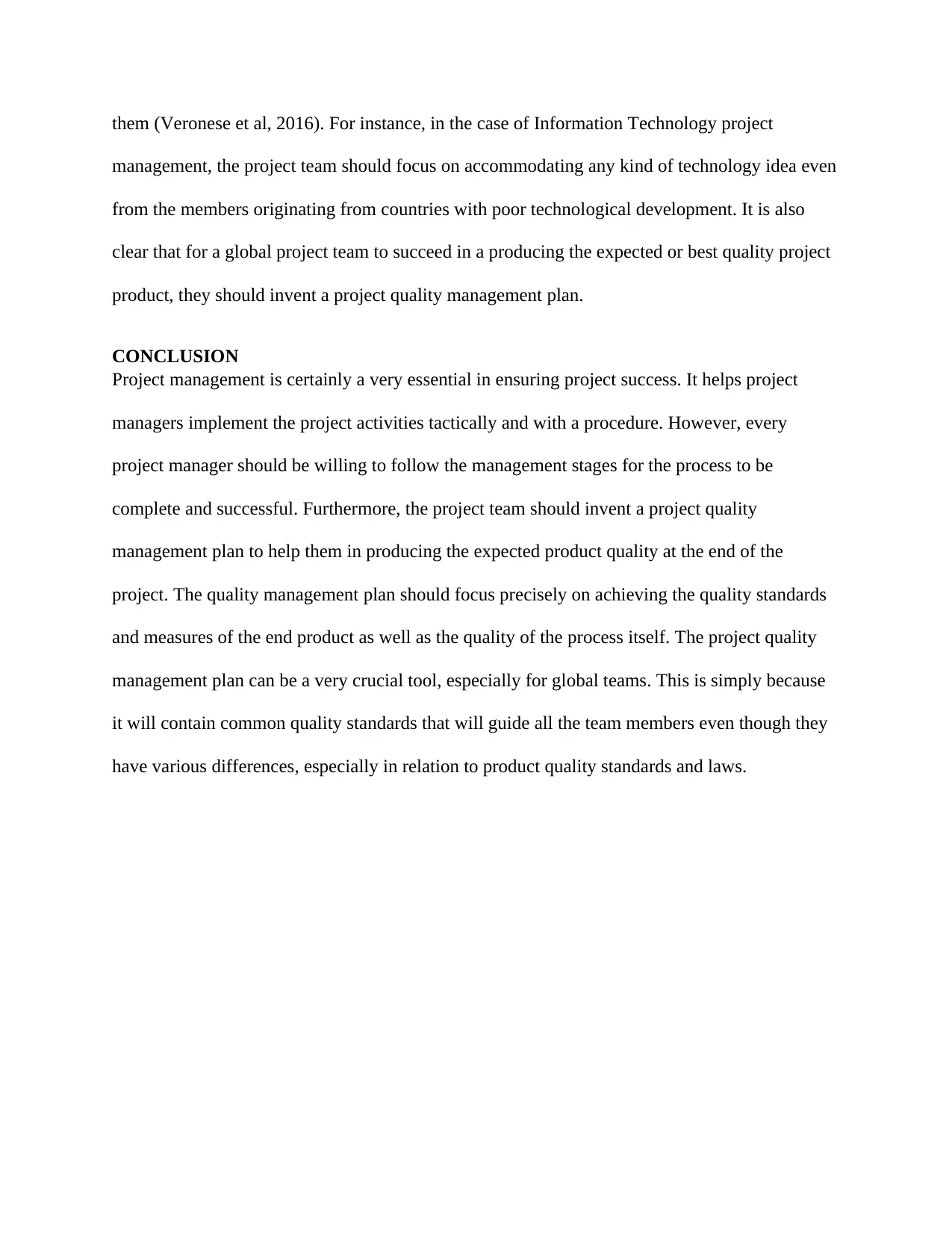
them (Veronese et al, 2016). For instance, in the case of Information Technology project
management, the project team should focus on accommodating any kind of technology idea even
from the members originating from countries with poor technological development. It is also
clear that for a global project team to succeed in a producing the expected or best quality project
product, they should invent a project quality management plan.
CONCLUSION
Project management is certainly a very essential in ensuring project success. It helps project
managers implement the project activities tactically and with a procedure. However, every
project manager should be willing to follow the management stages for the process to be
complete and successful. Furthermore, the project team should invent a project quality
management plan to help them in producing the expected product quality at the end of the
project. The quality management plan should focus precisely on achieving the quality standards
and measures of the end product as well as the quality of the process itself. The project quality
management plan can be a very crucial tool, especially for global teams. This is simply because
it will contain common quality standards that will guide all the team members even though they
have various differences, especially in relation to product quality standards and laws.
management, the project team should focus on accommodating any kind of technology idea even
from the members originating from countries with poor technological development. It is also
clear that for a global project team to succeed in a producing the expected or best quality project
product, they should invent a project quality management plan.
CONCLUSION
Project management is certainly a very essential in ensuring project success. It helps project
managers implement the project activities tactically and with a procedure. However, every
project manager should be willing to follow the management stages for the process to be
complete and successful. Furthermore, the project team should invent a project quality
management plan to help them in producing the expected product quality at the end of the
project. The quality management plan should focus precisely on achieving the quality standards
and measures of the end product as well as the quality of the process itself. The project quality
management plan can be a very crucial tool, especially for global teams. This is simply because
it will contain common quality standards that will guide all the team members even though they
have various differences, especially in relation to product quality standards and laws.
Paraphrase This Document
Need a fresh take? Get an instant paraphrase of this document with our AI Paraphraser

REFERENCES
Alami, A. (2016). Global Project Management Challenges.
Chaves, M. S., Araújo, C. D., Teixeira, L. R., Glória Júnior, I., Rosa, D., & Nogueira, C. D.
(2016). A new approach to managing Lessons Learned in PMBoK process groups: the
Ballistic 2.0 Model. International Journal of Information Systems and Project
Management, 4(1), 27-45.
Dale, B. (2015). Total quality management. John Wiley & Sons, Ltd.
Edkins, A., Geraldi, J., Morris, P., & Smith, A. (2013). Exploring the front-end of project
management. Engineering Project Organization Journal, 3(2), 71-85.
Howsawi, E. M., Eager, D., & Bagia, R. (2011, December). Understanding project success: The
four-level project success framework. In Industrial Engineering and Engineering
Management (IEEM), 2011 IEEE International Conference on (pp. 620-624). IEEE.
Alami, A. (2016). Global Project Management Challenges.
Chaves, M. S., Araújo, C. D., Teixeira, L. R., Glória Júnior, I., Rosa, D., & Nogueira, C. D.
(2016). A new approach to managing Lessons Learned in PMBoK process groups: the
Ballistic 2.0 Model. International Journal of Information Systems and Project
Management, 4(1), 27-45.
Dale, B. (2015). Total quality management. John Wiley & Sons, Ltd.
Edkins, A., Geraldi, J., Morris, P., & Smith, A. (2013). Exploring the front-end of project
management. Engineering Project Organization Journal, 3(2), 71-85.
Howsawi, E. M., Eager, D., & Bagia, R. (2011, December). Understanding project success: The
four-level project success framework. In Industrial Engineering and Engineering
Management (IEEM), 2011 IEEE International Conference on (pp. 620-624). IEEE.
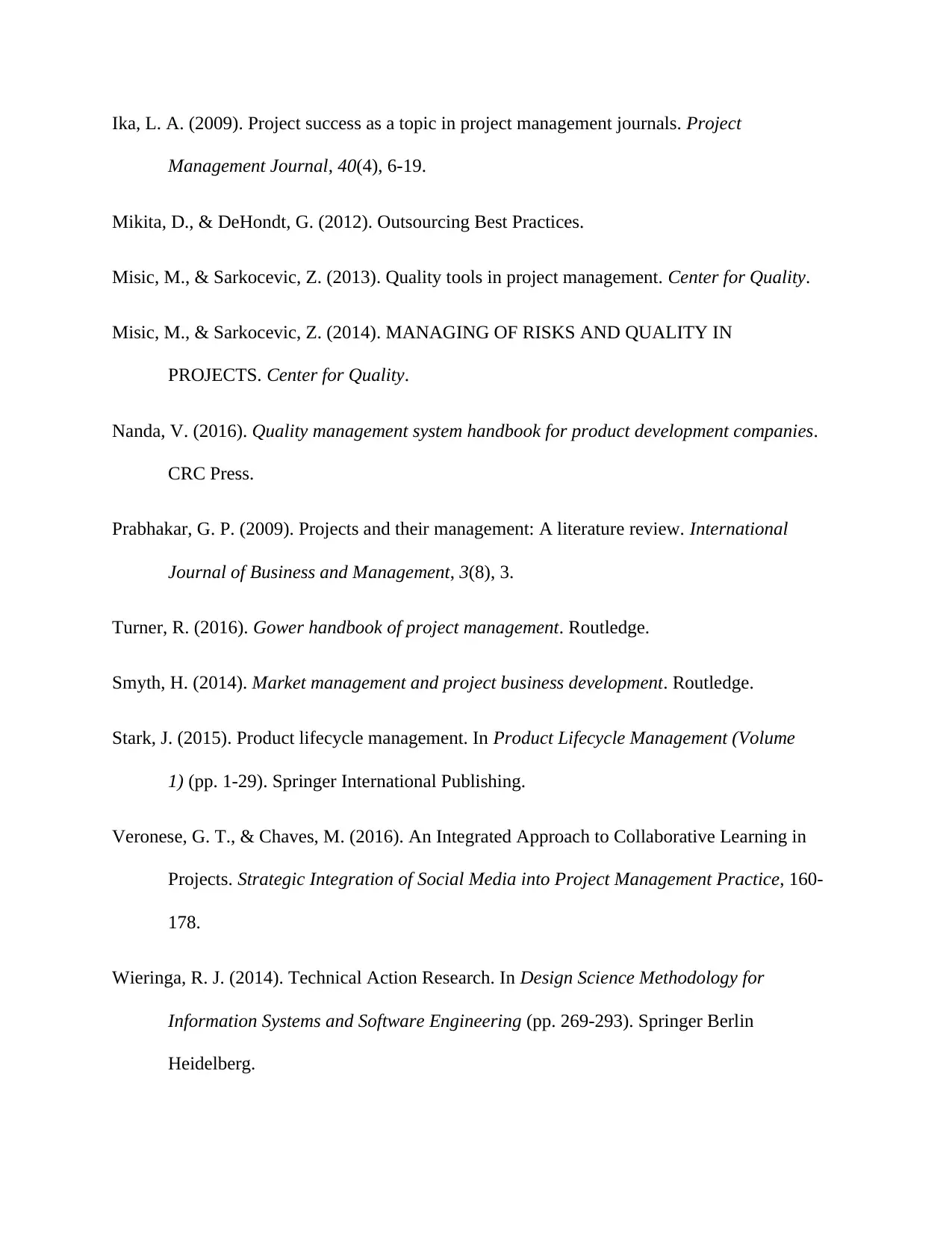
Ika, L. A. (2009). Project success as a topic in project management journals. Project
Management Journal, 40(4), 6-19.
Mikita, D., & DeHondt, G. (2012). Outsourcing Best Practices.
Misic, M., & Sarkocevic, Z. (2013). Quality tools in project management. Center for Quality.
Misic, M., & Sarkocevic, Z. (2014). MANAGING OF RISKS AND QUALITY IN
PROJECTS. Center for Quality.
Nanda, V. (2016). Quality management system handbook for product development companies.
CRC Press.
Prabhakar, G. P. (2009). Projects and their management: A literature review. International
Journal of Business and Management, 3(8), 3.
Turner, R. (2016). Gower handbook of project management. Routledge.
Smyth, H. (2014). Market management and project business development. Routledge.
Stark, J. (2015). Product lifecycle management. In Product Lifecycle Management (Volume
1) (pp. 1-29). Springer International Publishing.
Veronese, G. T., & Chaves, M. (2016). An Integrated Approach to Collaborative Learning in
Projects. Strategic Integration of Social Media into Project Management Practice, 160-
178.
Wieringa, R. J. (2014). Technical Action Research. In Design Science Methodology for
Information Systems and Software Engineering (pp. 269-293). Springer Berlin
Heidelberg.
Management Journal, 40(4), 6-19.
Mikita, D., & DeHondt, G. (2012). Outsourcing Best Practices.
Misic, M., & Sarkocevic, Z. (2013). Quality tools in project management. Center for Quality.
Misic, M., & Sarkocevic, Z. (2014). MANAGING OF RISKS AND QUALITY IN
PROJECTS. Center for Quality.
Nanda, V. (2016). Quality management system handbook for product development companies.
CRC Press.
Prabhakar, G. P. (2009). Projects and their management: A literature review. International
Journal of Business and Management, 3(8), 3.
Turner, R. (2016). Gower handbook of project management. Routledge.
Smyth, H. (2014). Market management and project business development. Routledge.
Stark, J. (2015). Product lifecycle management. In Product Lifecycle Management (Volume
1) (pp. 1-29). Springer International Publishing.
Veronese, G. T., & Chaves, M. (2016). An Integrated Approach to Collaborative Learning in
Projects. Strategic Integration of Social Media into Project Management Practice, 160-
178.
Wieringa, R. J. (2014). Technical Action Research. In Design Science Methodology for
Information Systems and Software Engineering (pp. 269-293). Springer Berlin
Heidelberg.
⊘ This is a preview!⊘
Do you want full access?
Subscribe today to unlock all pages.

Trusted by 1+ million students worldwide
1 out of 13
Related Documents
Your All-in-One AI-Powered Toolkit for Academic Success.
+13062052269
info@desklib.com
Available 24*7 on WhatsApp / Email
![[object Object]](/_next/static/media/star-bottom.7253800d.svg)
Unlock your academic potential
Copyright © 2020–2025 A2Z Services. All Rights Reserved. Developed and managed by ZUCOL.





